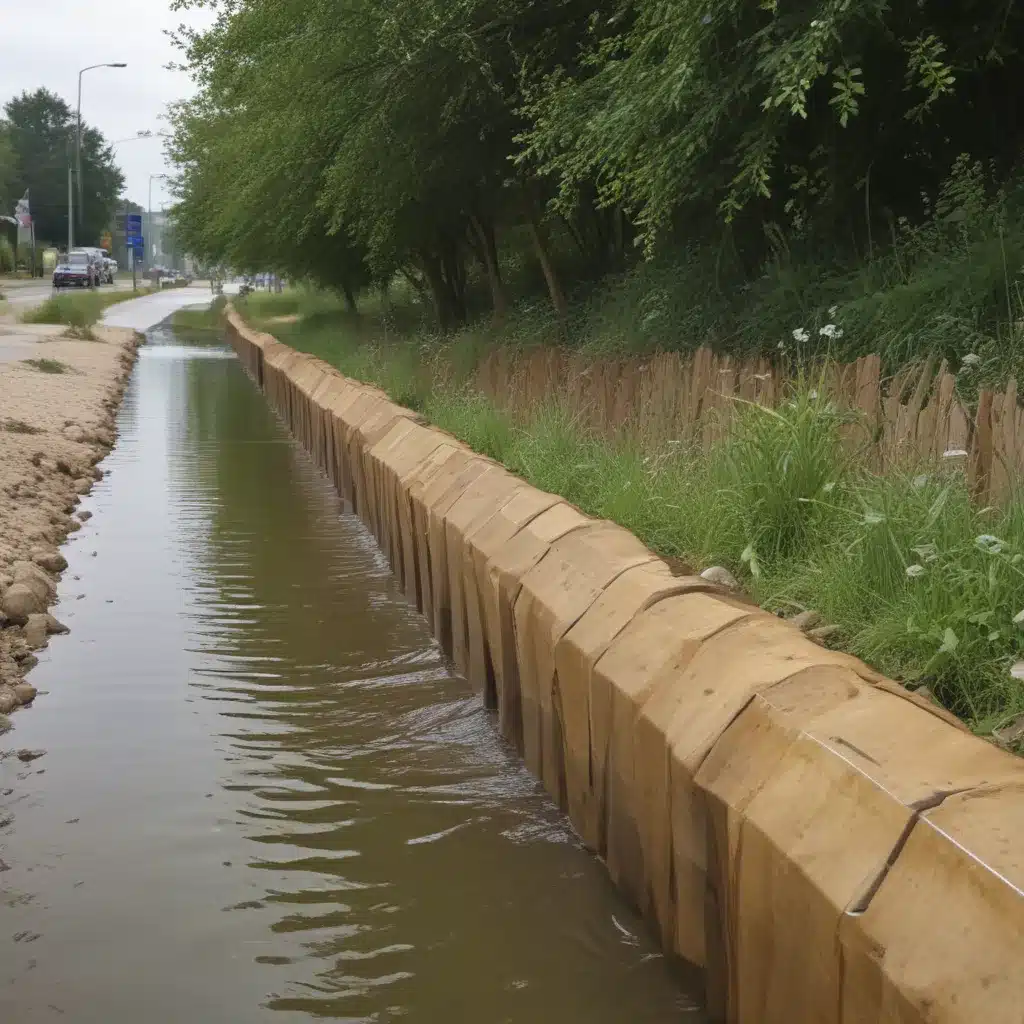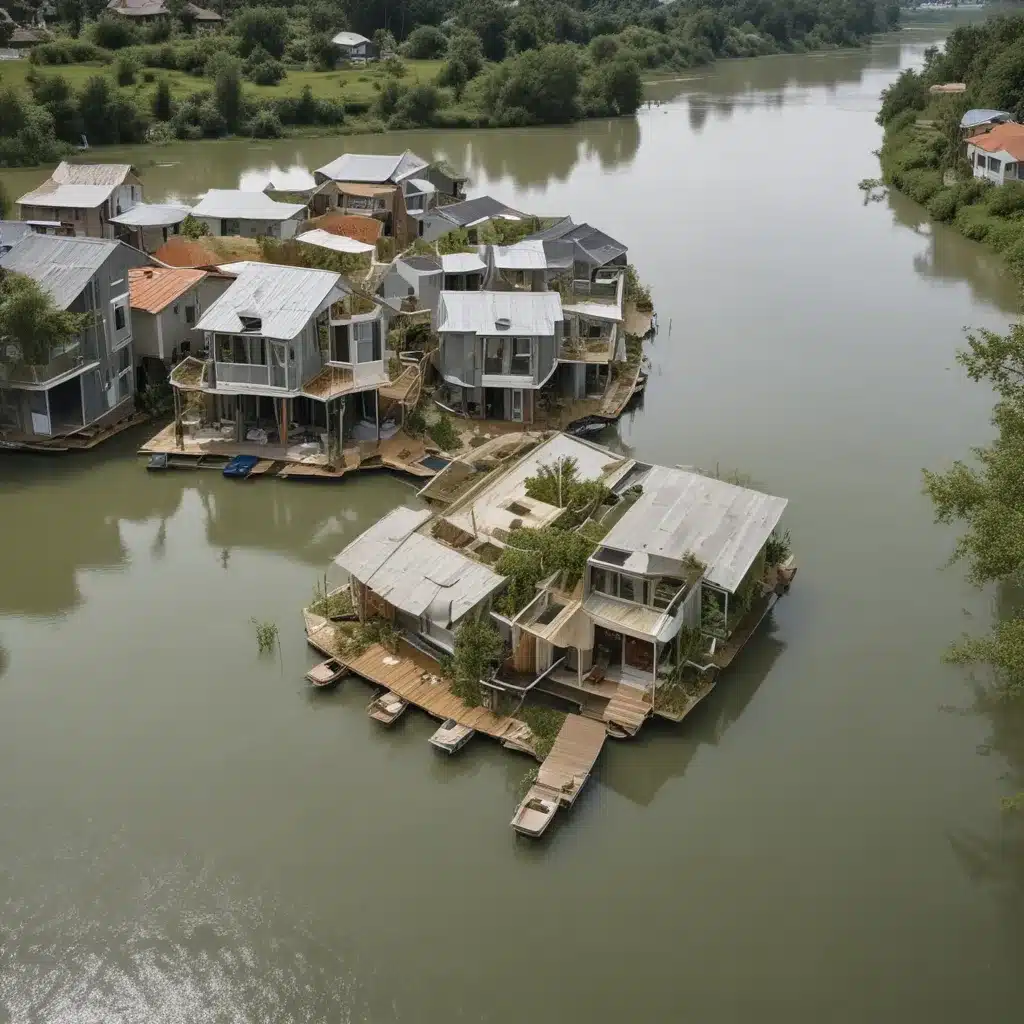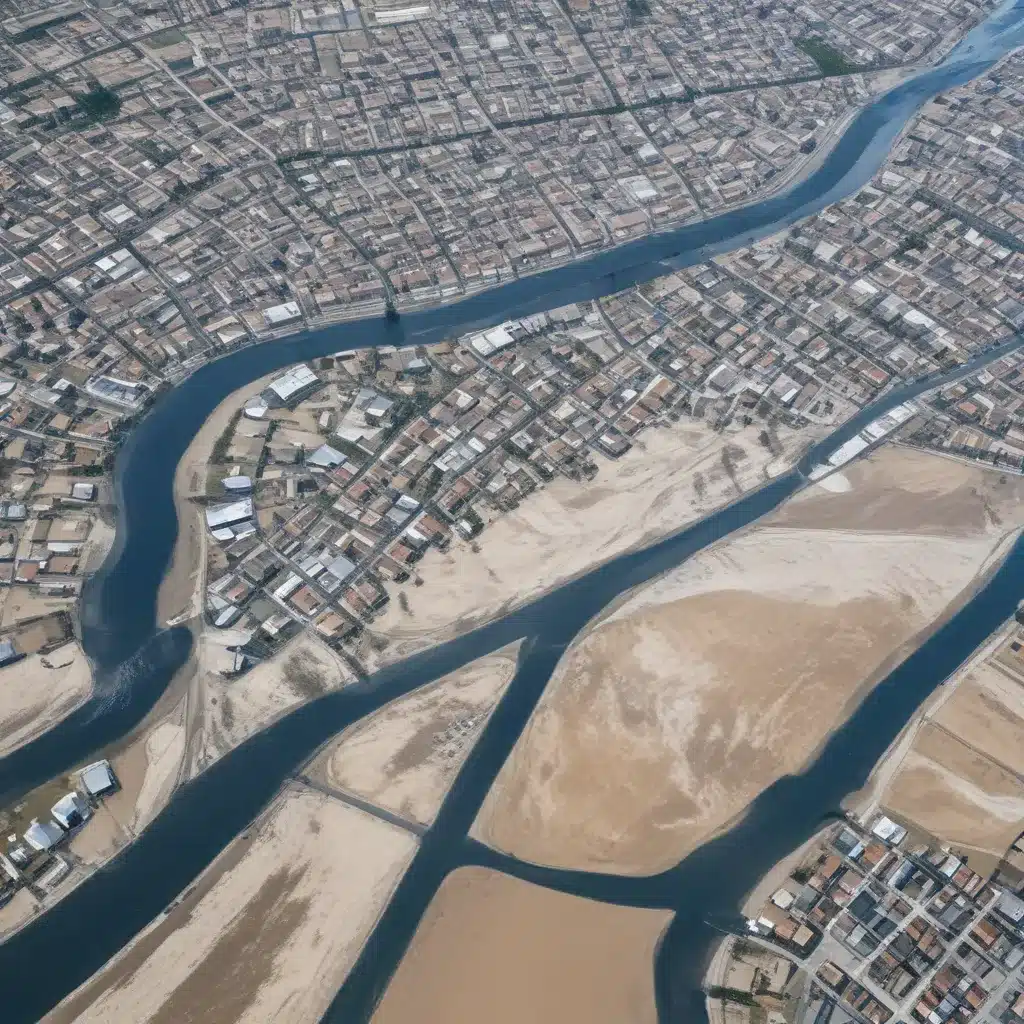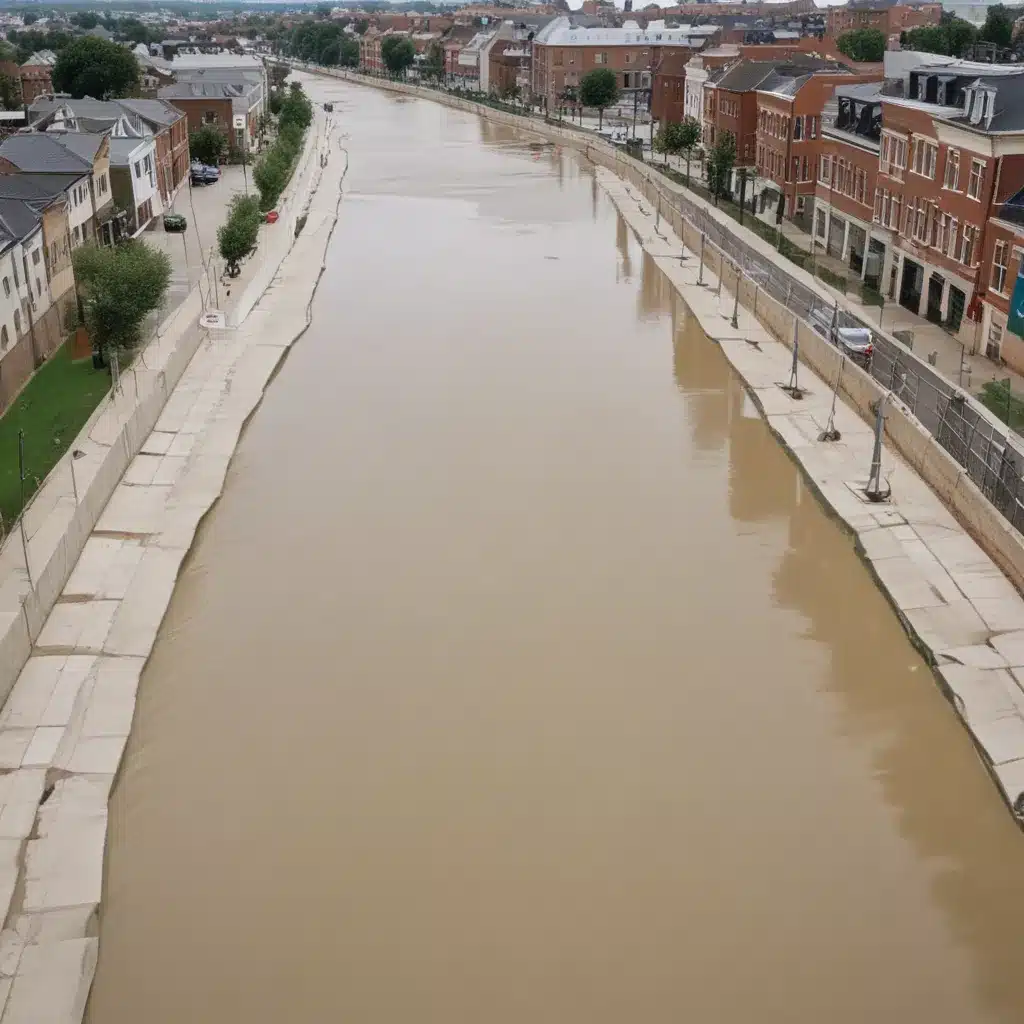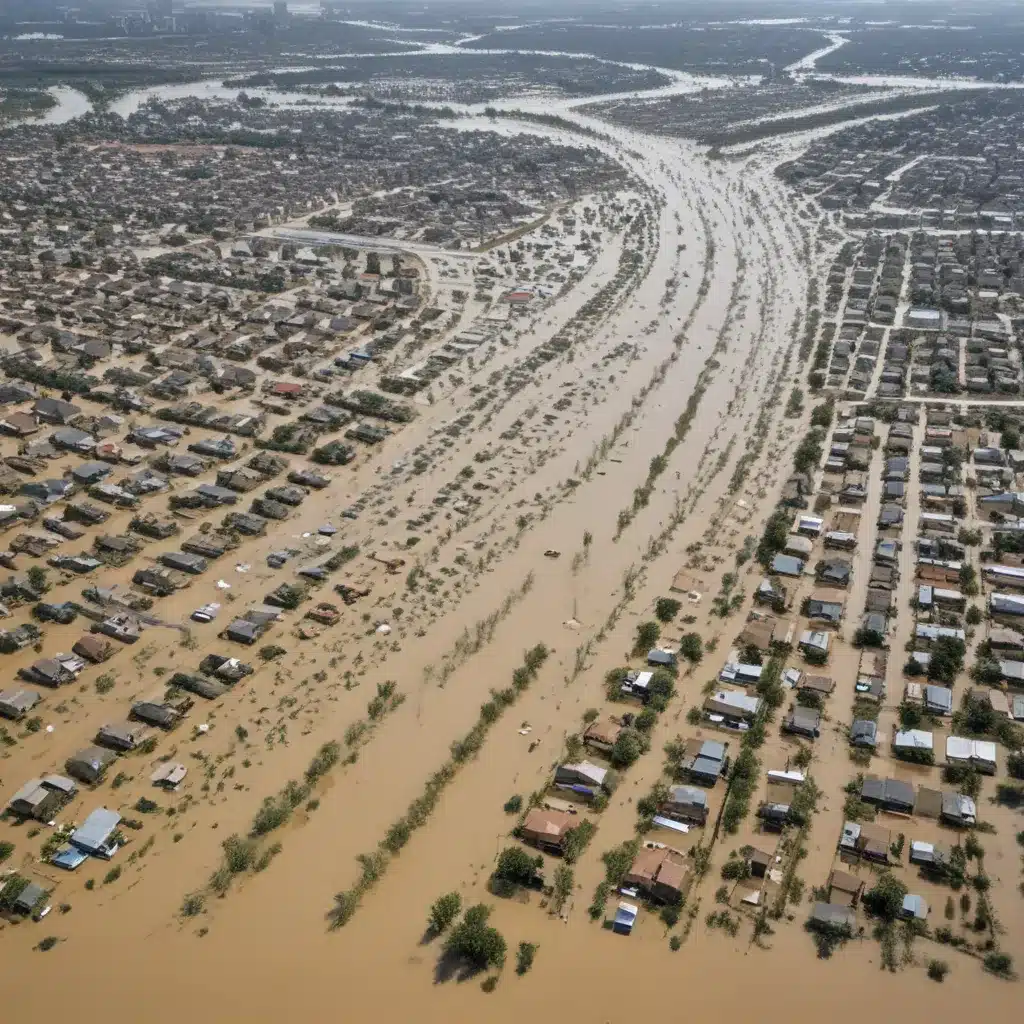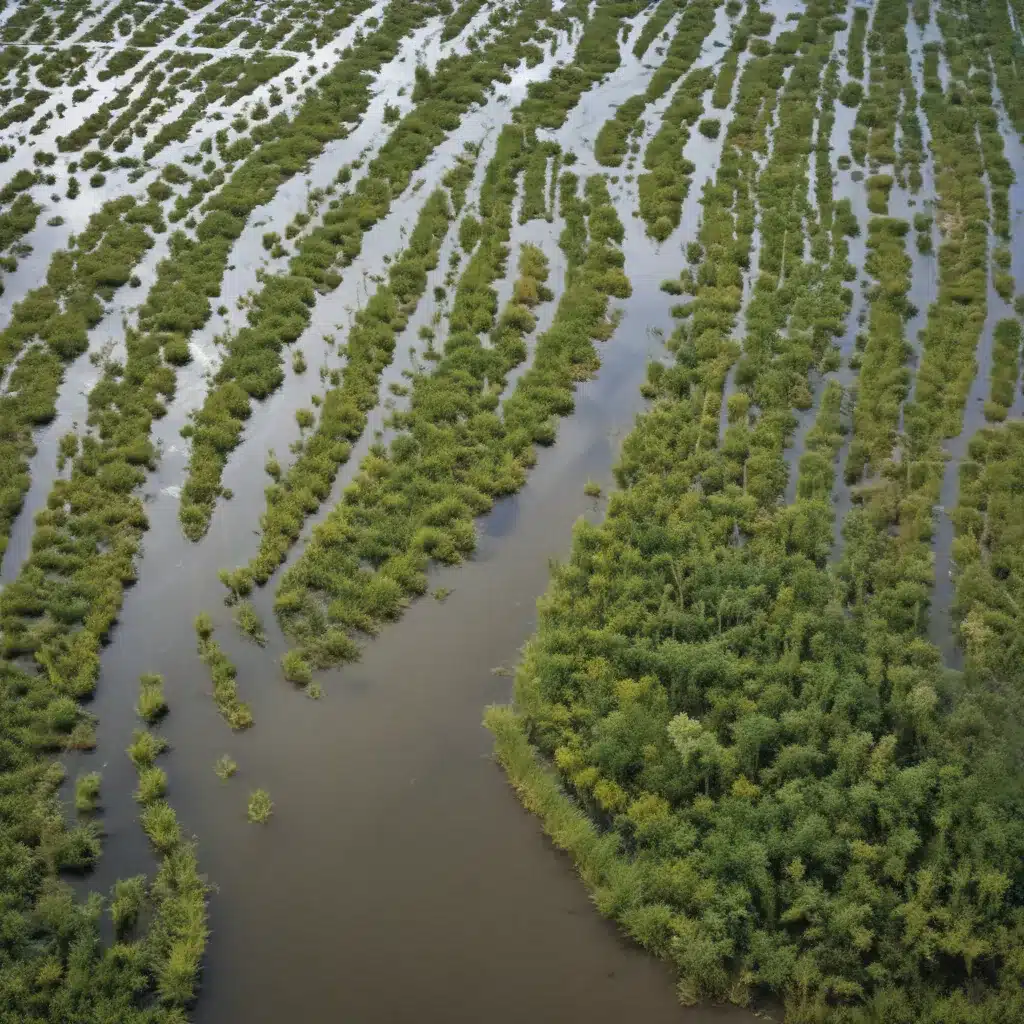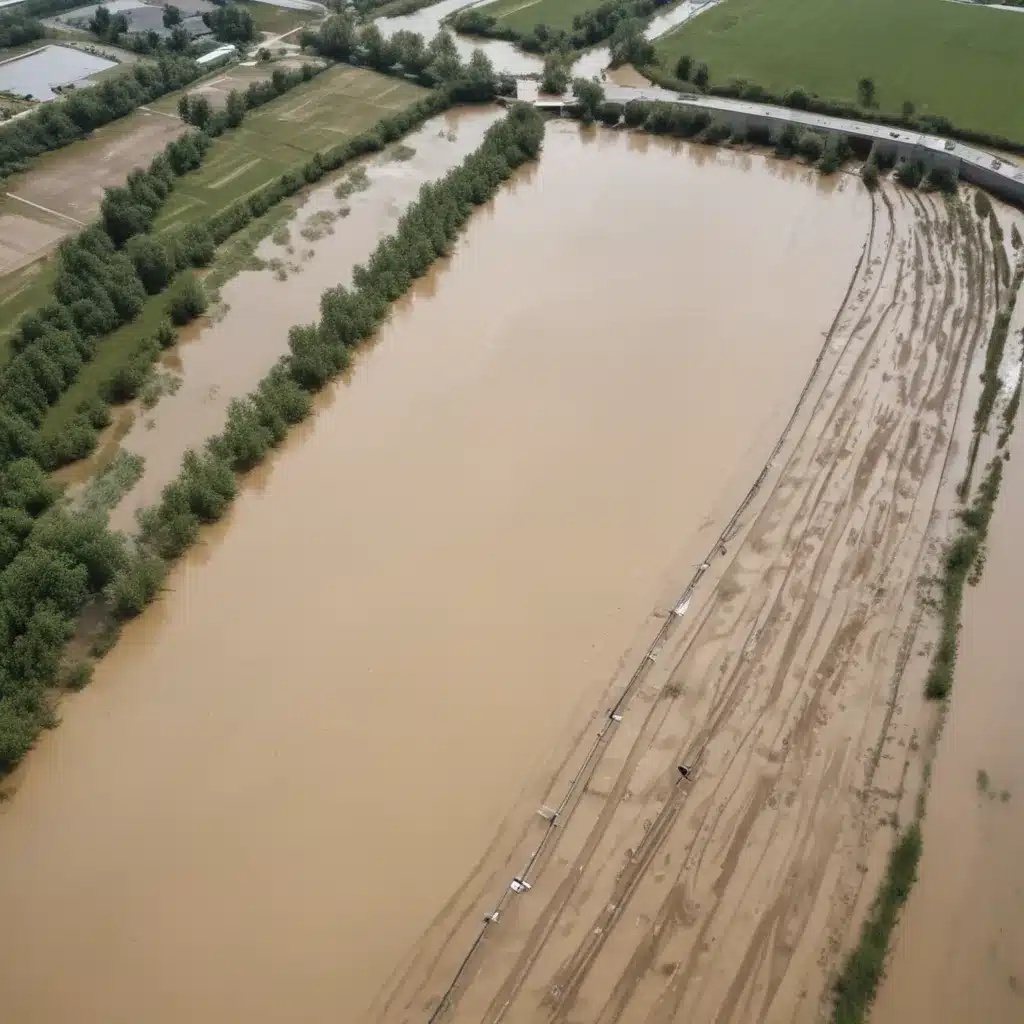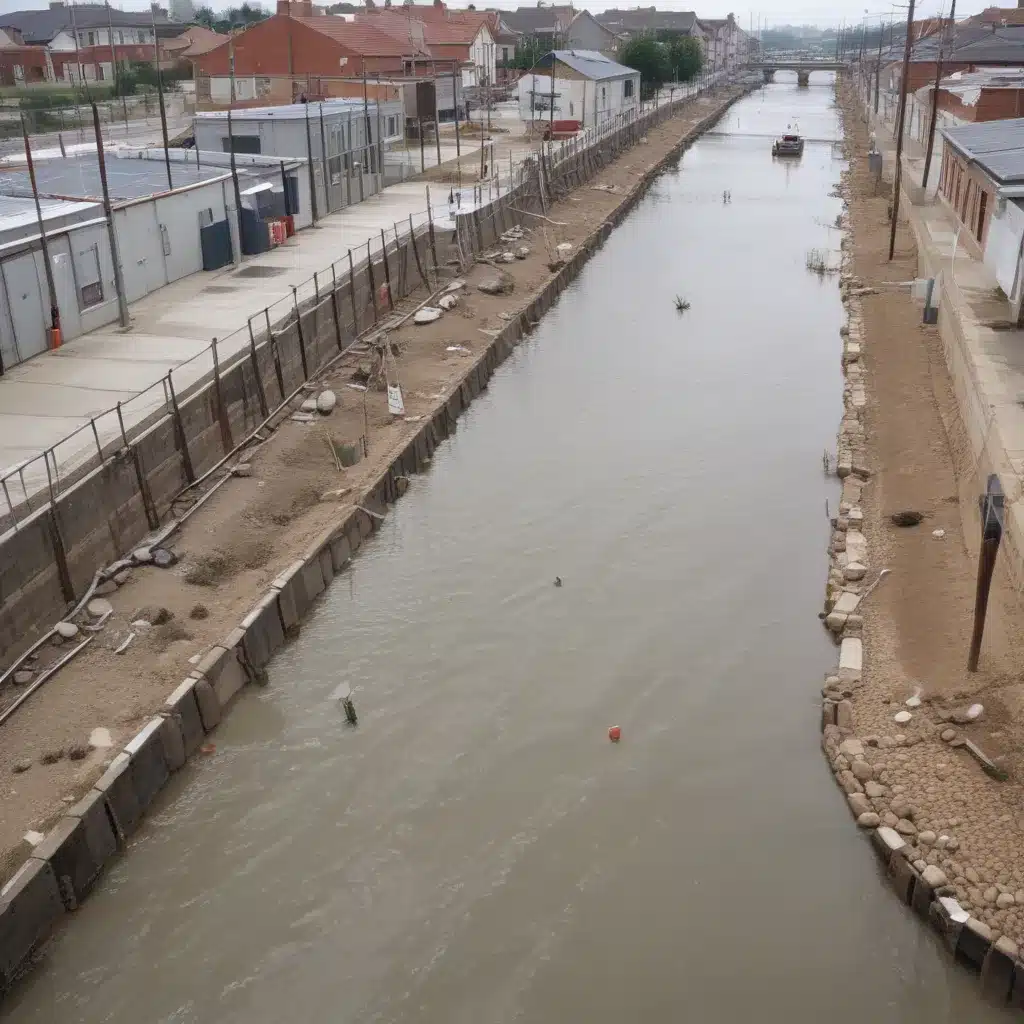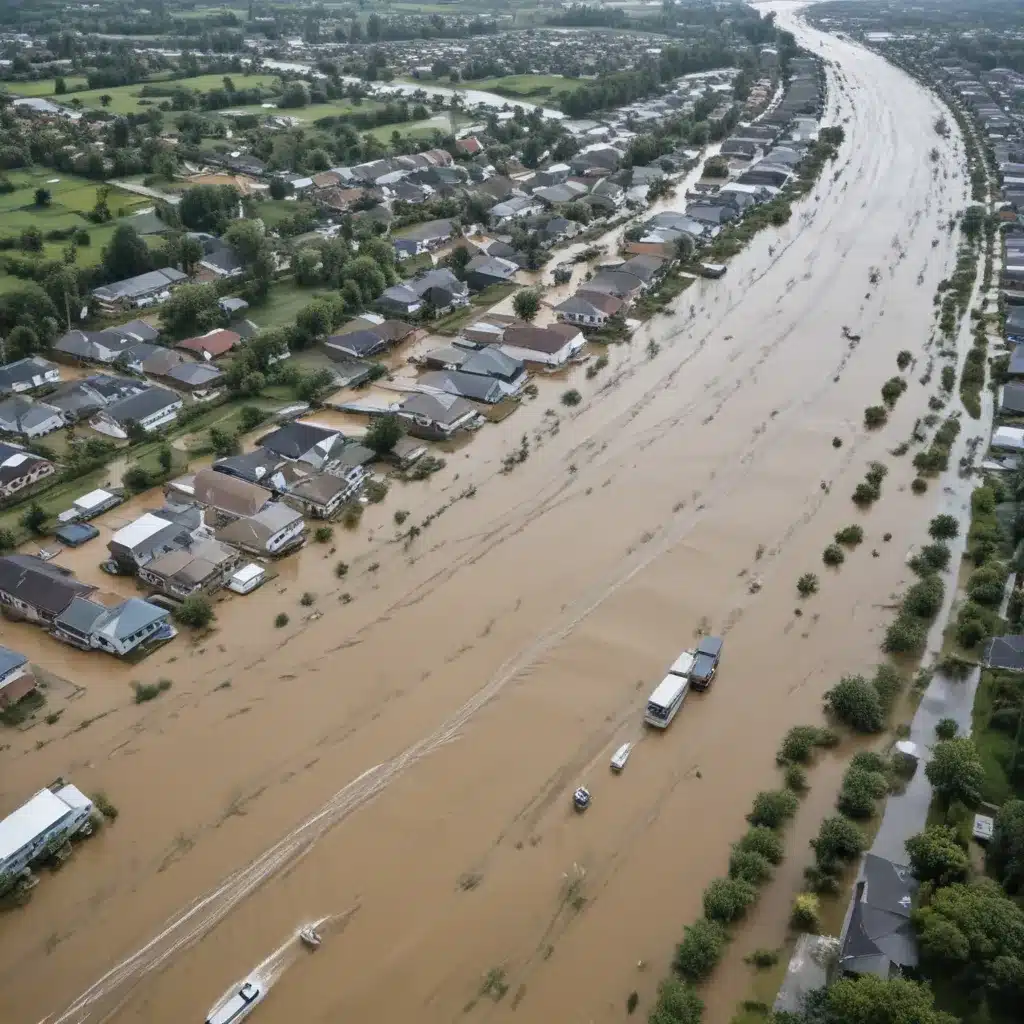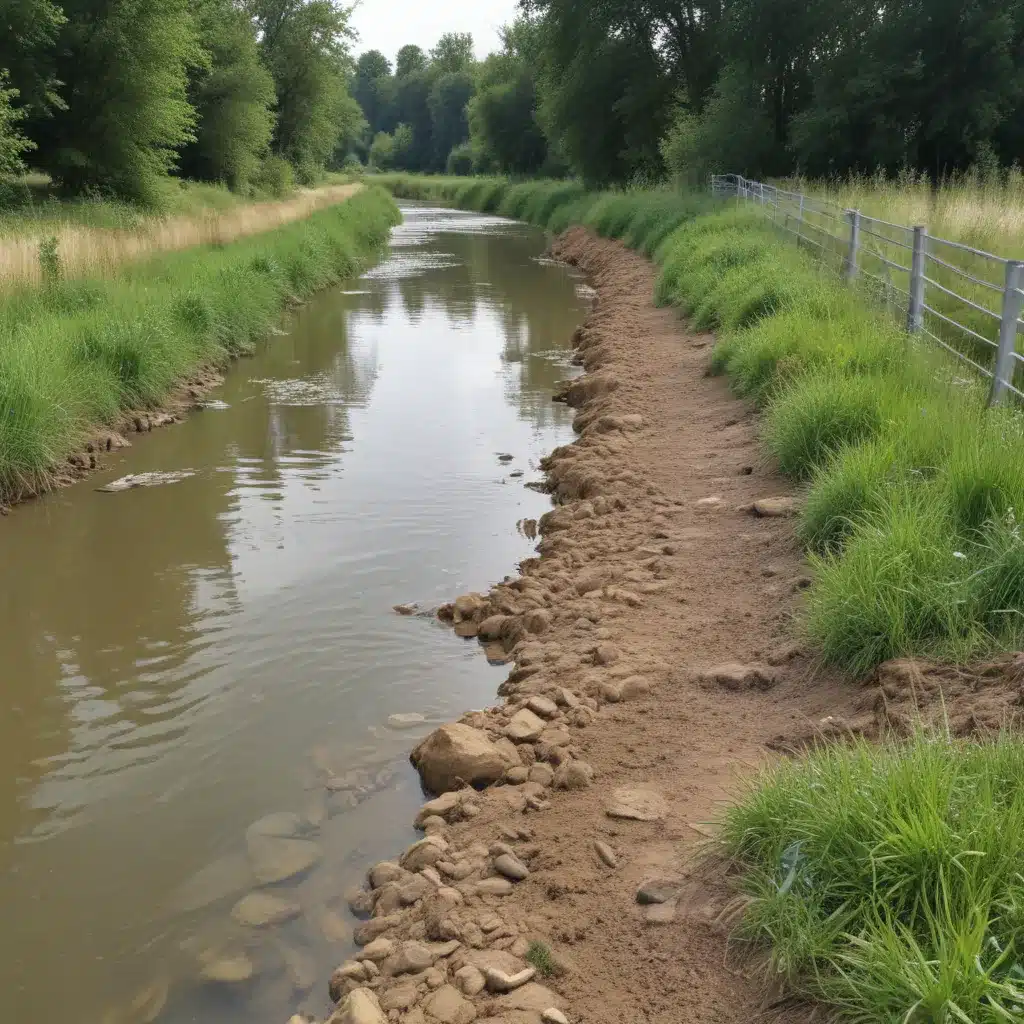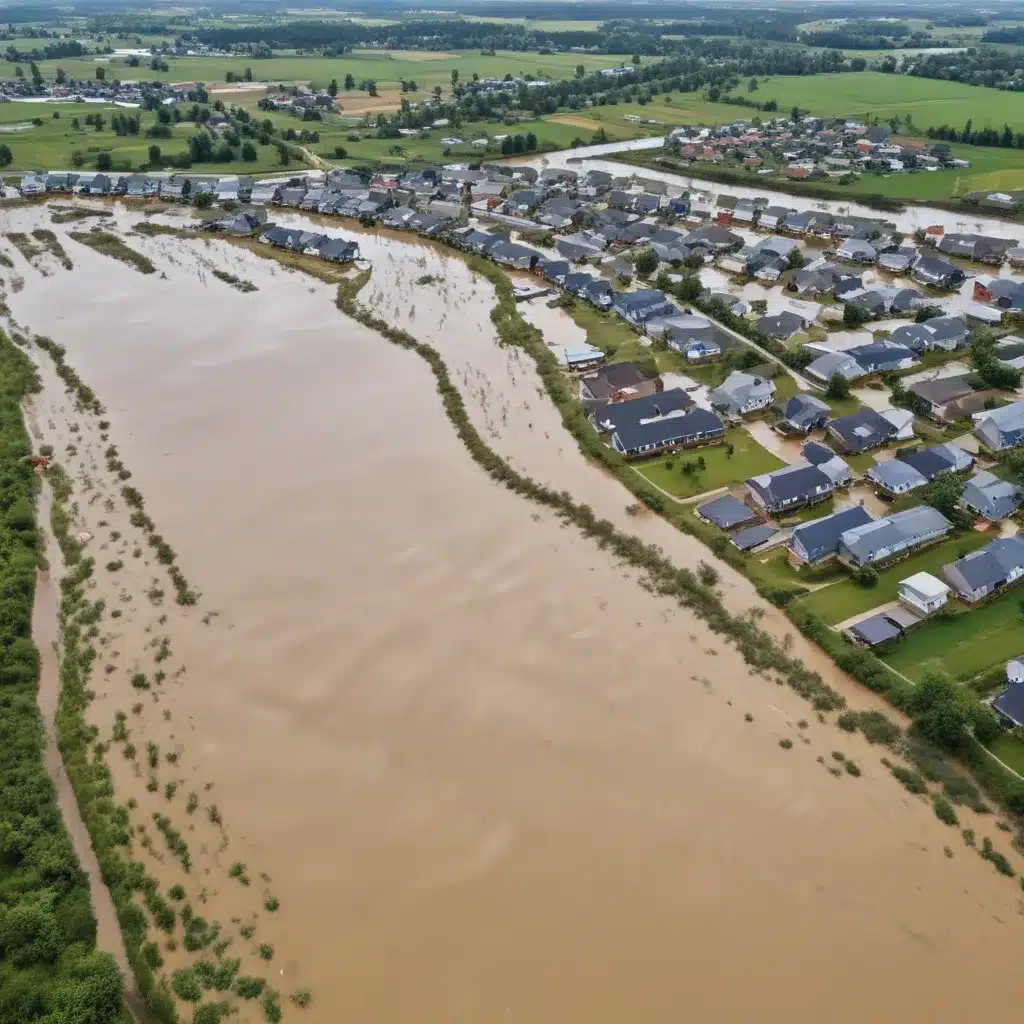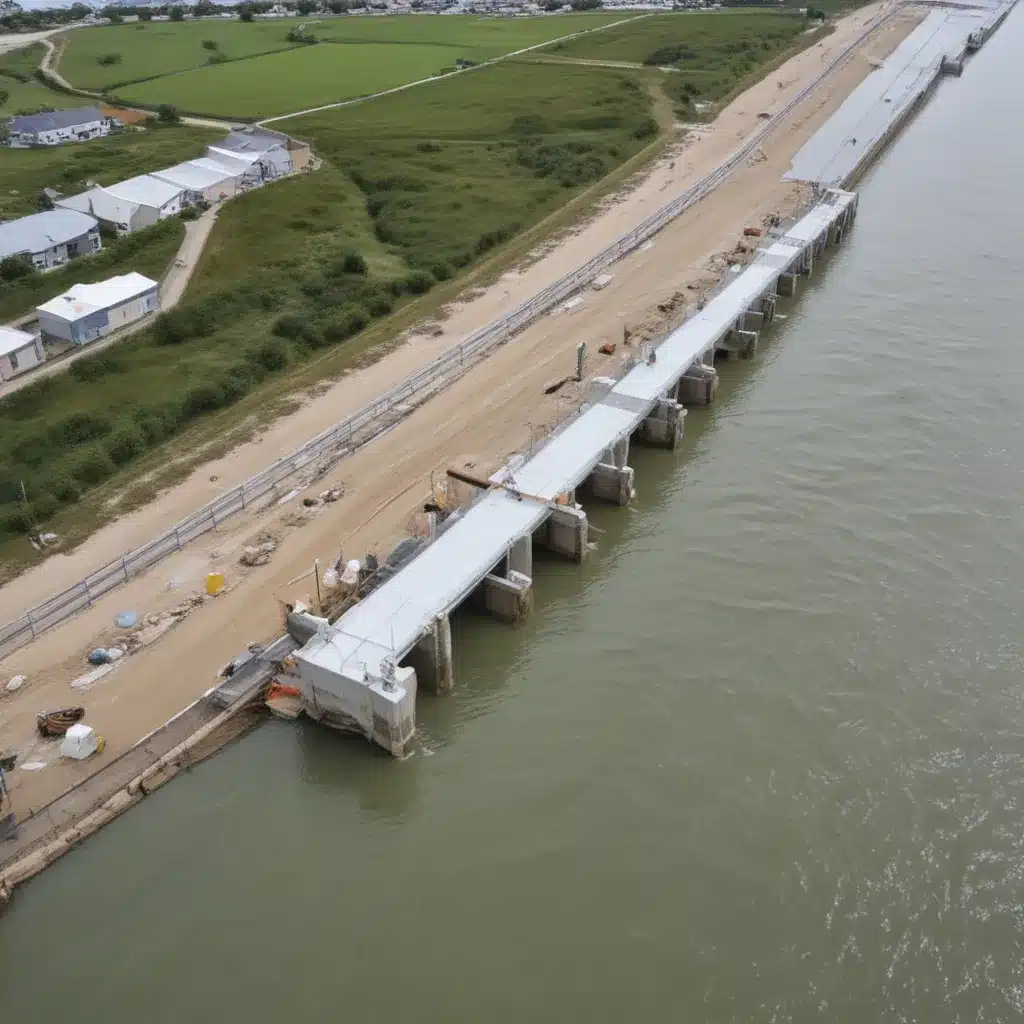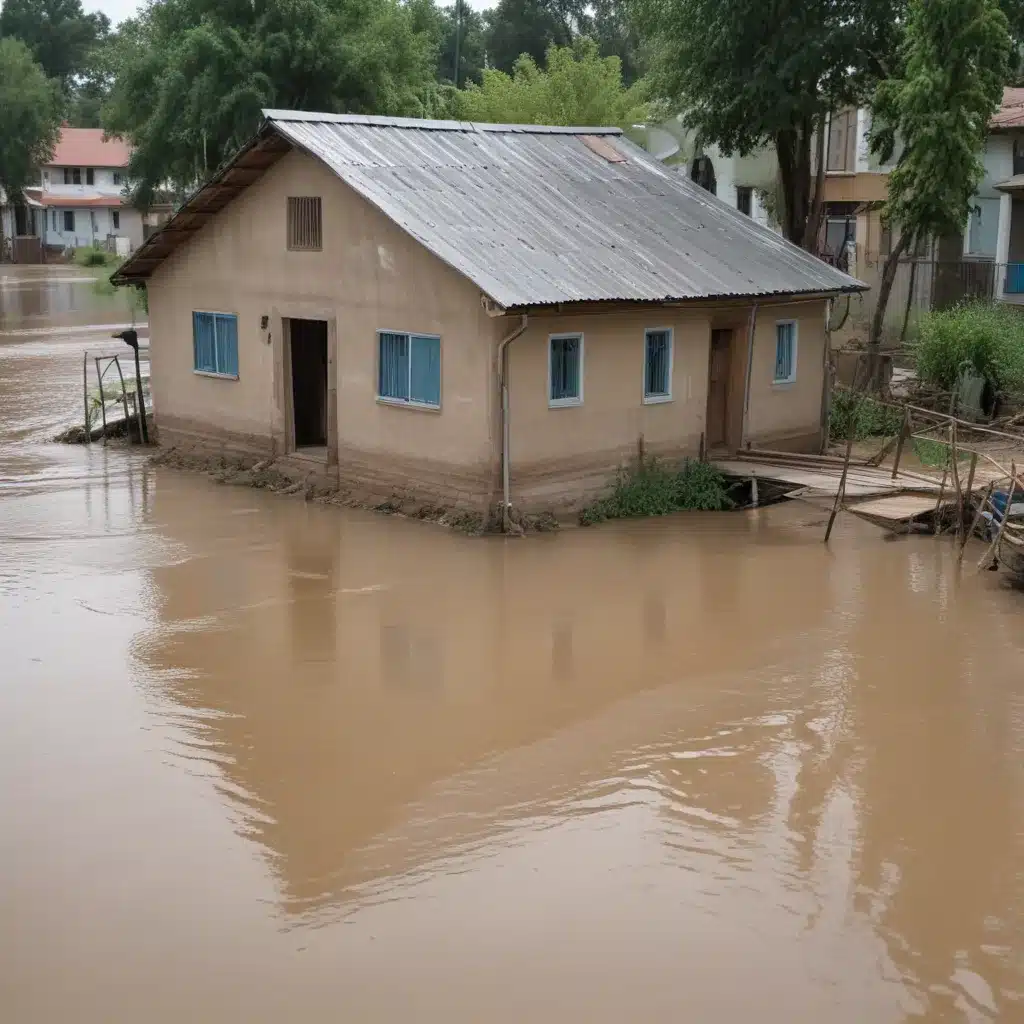Picture this: a bustling city, its streets flooded with water after a heavy downpour. People wade through knee-high water, their umbrellas barely providing any protection. It is in moments like these that innovative urban flood management projects become crucial. The need for effective solutions to tackle the challenges of urban flooding has never been greater. From green roofs that absorb rainwater to smart flood sensors that provide real-time data, there are a multitude of cutting-edge initiatives that are revolutionizing the way we deal with urban floods. In this discussion, we will explore some of these innovative projects, their impact, and how they are reshaping the urban landscape. Get ready to discover the future of urban flood management.
Key Takeaways
- Green infrastructure solutions such as urban green roofs, rainwater harvesting systems, permeable pavement technologies, and stormwater management parks are effective in managing urban floods, reducing stormwater runoff, and promoting sustainability.
- Innovative flood barrier designs, including modular systems, automatic activation, green infrastructure barriers, inflatable barriers, and smart barrier systems, provide flexible and ecological flood protection.
- Community engagement and education, such as organizing workshops, citizen science initiatives, volunteer programs, public outreach, and involving community members in decision-making, play a crucial role in successful urban flood management projects.
- Real-time flood monitoring systems enable immediate detection, early warning notifications, remote access to data, seamless integration with other flood management systems, and predictive flood modeling, improving overall flood management effectiveness.
- An integrated floodplain management approach that combines floodplain restoration, flood risk reduction measures, floodplain zoning, improved early warning systems, and comprehensive flood risk management plans helps minimize flood impacts on urban areas.
Urban Green Roofs
Urban green roofs are a sustainable solution to managing stormwater runoff in densely populated cities. They provide a multitude of benefits, including reducing the urban heat island effect and improving air quality. Green roofs are innovative and can transform the way we approach flood management in urban areas.
One of the key benefits of green roofs is their ability to mitigate the urban heat island effect. In cities, concrete and asphalt absorb and radiate heat, causing temperatures to rise significantly. Green roofs, on the other hand, absorb and retain less heat, helping to cool down the surrounding environment. This not only improves comfort for residents but also reduces the need for energy-intensive air conditioning, leading to lower energy consumption and greenhouse gas emissions.
Another advantage of green roofs is their ability to manage stormwater runoff. In densely populated cities, large amounts of rainwater can overwhelm traditional drainage systems, leading to flooding and water pollution. Green roofs act as a natural sponge, absorbing rainwater and slowly releasing it back into the atmosphere through evaporation and plant transpiration. This helps to alleviate the burden on drainage infrastructure and reduce the risk of flooding.
Moreover, green roofs contribute to improved air quality in urban areas. Plants on green roofs capture pollutants and particulate matter from the air, reducing their concentration and improving overall air quality. This is particularly important in densely populated cities where air pollution can have detrimental effects on public health.
Smart Flood Sensors
In our exploration of urban flood management projects, we now turn our attention to the implementation of smart flood sensors. These innovative devices play a crucial role in real-time flood monitoring systems, providing valuable data that helps cities respond effectively to flood events.
Smart flood sensors are equipped with advanced technology that allows them to constantly monitor water levels and detect potential flood risks. They are designed to be easily installed in various locations throughout a city, such as drainage systems, rivers, and canals. Once installed, these sensors continuously collect data and transmit it to a central control center in real-time.
The benefits of smart flood sensors are twofold. Firstly, they provide accurate and up-to-date information about water levels, enabling authorities to make informed decisions quickly. This data can be used to activate early warning systems, trigger evacuation procedures, and deploy emergency response teams to affected areas. By having access to real-time information, cities can effectively mitigate flood damage and protect their citizens.
Secondly, smart flood sensors also contribute to the development of flood prediction models. By analyzing historical data and patterns, these sensors allow authorities to identify flood-prone areas and implement preventive measures accordingly. This proactive approach helps cities to better plan land use, infrastructure development, and flood control strategies.
Floating Flood Resilient Homes
Floating flood resilient homes offer an innovative solution for cities facing the challenge of recurrent flooding. These homes are designed to withstand and adapt to rising water levels, providing a safe and secure living environment for residents. By incorporating floating architecture and flood-resistant design, these homes not only protect against flooding but also contribute to the overall resilience of urban areas.
To better understand the concept and benefits of floating flood resilient homes, let’s take a look at the following table:
| Features | Benefits |
|---|---|
| Floating foundation | Allows homes to rise with floodwaters |
| Flood-resistant design | Protects homes from water damage |
| Flexible infrastructure | Adapts to changing flood conditions |
| Sustainable materials | Reduces environmental impact and promotes longevity |
Floating flood resilient homes use a floating foundation that allows them to rise and fall with floodwaters, ensuring that the living spaces remain above the water level. This design feature not only protects the homes from damage but also allows residents to stay in their homes during and after a flood event.
Additionally, these homes are built with flood-resistant materials and incorporate design elements that prevent water infiltration. This ensures that the homes remain structurally sound and minimizes the need for costly repairs and renovations.
Moreover, the flexible infrastructure of these homes allows for easy adaptation to changing flood conditions. For example, movable walls and furniture can be adjusted to create additional space or protect valuable possessions during a flood.
Lastly, floating flood resilient homes prioritize sustainability by using environmentally friendly materials. This reduces the carbon footprint of the homes and promotes their longevity, making them a sustainable and resilient housing solution for flood-prone areas.
Rainwater Harvesting Systems
One effective solution for managing urban floods is the implementation of rainwater harvesting systems. These innovative rainwater management techniques play a crucial role in urban flood mitigation strategies.
Rainwater harvesting systems are designed to capture and store rainwater for later use. They involve the collection of rainwater from rooftops, pavements, and open spaces, which is then stored in tanks or underground reservoirs. This stored water can be used for various purposes, such as irrigation, landscaping, and even as a source of drinking water, thus reducing dependence on municipal water supply during times of flooding.
By implementing rainwater harvesting systems, cities can effectively manage excess rainfall and reduce the risk of urban flooding. These systems help in preventing stormwater runoff from overwhelming drainage systems and causing floods. Instead of allowing rainwater to flow into the streets and overwhelm existing infrastructure, it is captured and stored safely for future use.
Moreover, rainwater harvesting systems promote sustainability and environmental conservation. They reduce the strain on water resources by utilizing rainwater, which is a free and abundant source. By relying on rainwater for non-potable uses, cities can reduce their reliance on groundwater and surface water, leading to long-term water conservation.
Permeable Pavement Technologies
Permeable pavement technologies offer a sustainable solution for managing urban floods by allowing rainwater to infiltrate into the ground rather than contributing to stormwater runoff. These innovative permeable pavements are designed to provide a porous surface that allows water to pass through and be absorbed by the underlying soil, reducing the volume and velocity of runoff. This not only helps to mitigate flooding but also promotes sustainable urban drainage.
Permeable pavement innovations are gaining popularity in urban areas where traditional impermeable surfaces, such as concrete and asphalt, have contributed to the problem of excessive stormwater runoff. By incorporating permeable materials into the construction of roads, sidewalks, and parking lots, cities can effectively manage rainwater, reducing the strain on existing drainage systems.
To illustrate the effectiveness of permeable pavement technologies, let’s take a look at a comparison between traditional surfaces and permeable alternatives:
| Traditional Surface | Permeable Pavement |
|---|---|
| Concrete | Porous Concrete |
| Asphalt | Permeable Asphalt |
| Solid Sidewalks | Permeable Pavers |
| Non-porous Parking Lots | Porous Gravel Lots |
As you can see, permeable pavements provide a more sustainable approach to managing stormwater. These innovative solutions not only reduce the risk of flooding but also help to replenish groundwater supplies and improve water quality by filtering pollutants.
The implementation of permeable pavement technologies is a step towards creating more resilient and environmentally friendly cities. By embracing sustainable urban drainage strategies, we can effectively manage urban floods while promoting innovation and sustainability in our communities.
Underground Water Storage Solutions
To effectively manage urban floods and mitigate the risk of water damage, underground water storage solutions offer a practical and efficient approach. These innovative techniques are designed to store excess water during heavy rainfall and release it gradually when the storm subsides, alleviating the pressure on drainage systems. Here are five underground water storage solutions that are revolutionizing flood management in urban areas:
- Underground reservoirs: These large storage chambers are built beneath the ground to store excess water. They can hold a significant amount of water and release it slowly back into the environment, reducing the risk of flooding.
- Aquifer recharge: This method involves injecting excess water into underground aquifers, which are natural underground reservoirs of water. By replenishing these aquifers, we can maintain a sustainable water supply and reduce the risk of flooding during heavy rainfall.
- Modular storage systems: These systems consist of modular units that can be interconnected to create underground storage space. They are flexible and can adapt to different urban environments, making them ideal for flood-prone areas.
- Green roofs with water storage capacity: Green roofs are designed with vegetation and a layer of soil to absorb rainwater. By incorporating a water storage capacity beneath the green roof, excess water can be stored and released slowly, reducing the strain on drainage systems.
- Stormwater infiltration systems: These systems capture rainwater and allow it to infiltrate the ground through permeable surfaces. The water is then stored in underground reservoirs or infiltrated into the aquifer, minimizing the risk of urban flooding.
Stormwater Management Parks
Let’s talk about stormwater management parks, which are green infrastructure solutions designed to manage urban floods. These parks incorporate sustainable drainage systems to capture and filter stormwater, reducing the risk of flooding in urban areas. By utilizing these innovative solutions, we can effectively manage stormwater runoff and create sustainable, resilient communities.
Green Infrastructure Solutions
We can implement green infrastructure solutions, such as stormwater management parks, to effectively manage urban floods. These innovative strategies not only provide flood control but also offer additional benefits to the community and the environment. Here are some key reasons why stormwater management parks are a valuable solution for urban flood resilience:
- Green roofs implementation: Incorporating green roofs into buildings helps absorb rainfall and reduce stormwater runoff, easing the burden on drainage systems.
- Enhanced water quality: Stormwater management parks use natural filtration processes to improve the quality of water before it enters rivers and streams.
- Biodiversity promotion: These parks create habitats for various plants, animals, and insects, contributing to urban biodiversity and ecological balance.
- Recreational spaces: Stormwater management parks can be designed as multifunctional spaces, providing recreational areas for the community to enjoy.
- Climate change adaptation: By managing stormwater effectively, these parks enhance the city’s resilience to extreme weather events caused by climate change.
Implementing green infrastructure solutions like stormwater management parks is a promising step towards building more sustainable and flood-resilient cities.
Sustainable Drainage Systems
Implementing sustainable drainage systems, such as stormwater management parks, is crucial for effectively managing urban floods and building flood-resilient cities. These innovative urban floodplain management approaches offer a range of benefits, including the use of permeable pavement. This type of pavement allows water to infiltrate through the surface, reducing runoff and the risk of flooding. By incorporating permeable pavement in stormwater management parks, we can capture and treat rainwater, replenish groundwater, and minimize the strain on traditional drainage systems. Additionally, these parks provide recreational spaces for communities, enhancing the quality of urban life. By embracing sustainable drainage systems, we not only address the challenges of urban flooding but also promote a greener and more resilient future for our cities.
Innovative Flood Barrier Designs
In recent years, there have been significant advancements in the design of flood barriers, allowing for more effective and efficient urban flood management. These innovative flood barrier designs have revolutionized the way we prevent and manage floods in our cities. Here are five exciting developments that are transforming flood prevention:
- Modular Barrier Systems: These systems consist of interlocking panels that can be quickly assembled and disassembled. They offer flexibility in adapting to different flood scenarios and can be easily transported and stored when not in use.
- Automatic Barrier Activation: Traditional flood barriers require manual deployment, which can be time-consuming and prone to error. New designs incorporate sensors and automated systems that activate the barriers when water levels rise, ensuring a swift response to flood threats.
- Green Infrastructure Barriers: These innovative flood barriers integrate natural elements, such as vegetation and permeable materials, to enhance flood protection while also providing aesthetic and ecological benefits. They not only prevent floodwaters from entering urban areas but also help mitigate stormwater runoff.
- Inflatable Barriers: Utilizing inflatable materials, these barriers can be rapidly deployed and easily stored when not in use. They offer a lightweight and portable solution that can be quickly installed in areas prone to flooding, providing temporary protection during heavy rainfall events.
- Smart Barrier Systems: These advanced flood barriers incorporate technologies like artificial intelligence, remote monitoring, and real-time data analysis. They enable early warning systems, predictive analytics, and adaptive responses, optimizing flood management strategies and enhancing overall effectiveness.
These innovative flood barrier designs are revolutionizing urban flood management, providing more effective and efficient ways to prevent and mitigate floods. With these advancements, we can better protect our cities and communities from the devastating impacts of flooding, ensuring a safer and more resilient future.
Urban Wetland Restoration Projects
Let’s talk about the benefits of urban wetland restoration projects. These projects not only enhance wetland biodiversity but also provide natural storage for floodwater. Additionally, they create opportunities for community engagement, giving residents a chance to connect with and appreciate their local environment.
Wetland Biodiversity Benefits
Restoring urban wetlands provides numerous benefits for wetland biodiversity. Urban wetland restoration projects play a crucial role in wetland conservation and the preservation of ecosystem services. Here are some key benefits of urban wetland restoration:
- Enhancing biodiversity: By restoring urban wetlands, we create habitats for a wide range of plant and animal species. This promotes biodiversity and helps in conserving endangered species.
- Improving water quality: Urban wetlands act as natural filters, removing pollutants and sediment from stormwater runoff. This improves water quality and protects aquatic ecosystems.
- Mitigating flooding: Wetlands have the ability to absorb excess water during heavy rainfall events, reducing the risk of urban flooding. This helps in managing stormwater and preventing damage to infrastructure.
- Carbon sequestration: Wetlands are highly effective in capturing and storing carbon dioxide from the atmosphere. By restoring urban wetlands, we contribute to climate change mitigation.
- Educational and recreational opportunities: Urban wetlands provide valuable spaces for education and recreation, allowing people to connect with nature and learn about wetland ecosystems.
Natural Floodwater Storage
By restoring urban wetlands, we can effectively create natural floodwater storage areas. This innovative approach to natural floodwater management is gaining momentum in urban planning and sustainability efforts. Urban wetland restoration projects focus on reviving and enhancing the natural wetland ecosystems within cities, which can provide multiple benefits, including flood mitigation. These restored wetlands act as natural sponges, absorbing excess water during heavy rainfall events and slowly releasing it back into the environment. Additionally, they play a crucial role in river channel restoration by improving water quality, reducing erosion, and providing habitat for diverse plant and animal species. By integrating natural floodwater storage into urban landscapes, we can not only manage flooding but also enhance the overall resilience and sustainability of our cities.
Community Engagement Opportunities
Engaging the community is crucial for the success of urban wetland restoration projects. Community workshops and citizen science initiatives provide excellent opportunities for the public to actively participate in the restoration process. Here are some ways in which community engagement can be fostered:
- Community Workshops: Organizing workshops where community members can learn about wetland ecosystems, restoration techniques, and the importance of urban wetlands in flood management.
- Citizen Science Initiatives: Encouraging citizens to collect data and contribute to scientific research by monitoring water quality, wildlife populations, and vegetation growth in restored wetland areas.
- Volunteer Programs: Creating volunteer programs that allow community members to get involved in hands-on restoration activities such as planting native vegetation or removing invasive species.
- Public Outreach: Conducting awareness campaigns through social media, local events, and educational programs to inform the public about the benefits of urban wetland restoration.
- Collaborative Decision-Making: Involving community members in the decision-making process by seeking their input, ideas, and concerns to ensure that the restoration projects align with their needs and aspirations.
Real-time Flood Monitoring Systems
Our urban flood management projects include the implementation of real-time flood monitoring systems. These systems play a crucial role in ensuring the safety and well-being of our communities by providing real-time flood prediction and early warning systems. By continuously monitoring water levels, rainfall, and weather conditions, we can accurately assess the risk of flooding and take proactive measures to mitigate its impact.
To give you a better understanding of the effectiveness of real-time flood monitoring systems, let’s take a look at the following table:
| System Features | Benefits |
|---|---|
| Real-time data | Immediate flood detection |
| Automated alerts | Early warning notifications |
| Remote monitoring | Real-time access to data |
| Integration | Seamless integration with other flood management systems |
| Data analytics | Predictive flood modeling |
| Decision support tools | Informed decision-making |
By utilizing these innovative technologies, we can revolutionize the way we manage floods in urban areas. Real-time flood monitoring systems provide us with invaluable insights, enabling us to respond swiftly and effectively during flood events. With automated alerts and remote monitoring, we can ensure that early warnings reach the right people at the right time, allowing for timely evacuations and emergency response.
Furthermore, the integration of real-time flood monitoring systems with other flood management systems enhances our ability to coordinate resources and implement targeted measures. By analyzing the data collected, we can develop predictive flood models, enabling us to anticipate flood patterns and plan for future events.
Green Infrastructure Networks
Now let’s explore the next aspect of our urban flood management projects: the implementation of green infrastructure networks. These networks are innovative solutions that not only help manage floodwaters but also bring numerous benefits to urban areas. Here are some key points to consider:
- Urban farming: Green infrastructure networks provide opportunities for urban farming, allowing residents to grow their own food and promote food security within the city. Rooftop gardens, vertical farming, and community gardens can be integrated into the design of these networks, creating sustainable and accessible sources of fresh produce.
- Improved water quality: Green infrastructure networks incorporate vegetation, such as rain gardens and bioswales, which naturally filter and purify stormwater runoff. By reducing the amount of pollutants entering our waterways, these networks help improve water quality and protect our ecosystems.
- Enhanced biodiversity: By creating green spaces within urban areas, these networks provide habitats for a variety of plant and animal species. This not only promotes biodiversity but also contributes to creating a healthier and more resilient urban environment.
- Reduced urban heat island effect: Green infrastructure networks help combat the urban heat island effect by providing shade and cooling effects. Trees, green roofs, and permeable pavements help reduce surface temperatures, making cities more comfortable and energy-efficient.
- Green infrastructure financing: Implementing green infrastructure networks requires proper financing mechanisms. Innovative funding models, such as public-private partnerships and green bonds, can be explored to secure the necessary resources for designing, constructing, and maintaining these networks.
Smart Stormwater Management Apps
Let’s talk about the features and benefits of smart stormwater management apps, as well as some case studies and success stories. These apps offer a range of functionalities, such as real-time monitoring of water levels, predictive analytics for flood forecasting, and interactive maps for visualizing flood-prone areas. They not only help individuals and communities stay informed and prepared during heavy rainfall events, but also enable decision-makers to make more effective flood management strategies.
App Features and Benefits
Smart stormwater management apps offer a range of features and benefits that enhance urban flood management systems. These innovative apps leverage app development and data analysis to provide real-time information and insights for effective flood management. Here are some key features and benefits of smart stormwater management apps:
- Real-time monitoring: These apps provide real-time data on rainfall intensity, water levels, and flood risks, allowing for proactive decision-making and timely responses.
- Predictive analytics: By analyzing historical and real-time data, these apps can predict flood events, enabling authorities to implement preventive measures and mitigate potential damage.
- Alerts and notifications: Smart stormwater management apps send alerts and notifications to residents and emergency services, ensuring timely evacuation and response during flood events.
- Data visualization: These apps use interactive maps and visualizations to present flood-related data in a user-friendly manner, making it easier for users to understand and respond to flood risks.
- Community engagement: Smart stormwater management apps encourage community participation by allowing users to report flooding incidents, share information, and collaborate with authorities in flood management efforts.
With these features and benefits, smart stormwater management apps play a crucial role in revolutionizing urban flood management and improving resilience in cities.
Urban Floodplain Restoration Initiatives
We have identified several urban floodplain restoration initiatives that have been successful in mitigating flood risks and restoring natural habitats. These projects showcase innovative approaches to urban floodplain management strategies and flood risk reduction measures. Here are some noteworthy initiatives:
- Green Infrastructure Implementation: Many cities are now implementing green infrastructure projects, such as rain gardens, bioswales, and green roofs, to restore floodplains. These features help absorb and retain stormwater, reducing the volume of water entering the floodplain and alleviating flood risks.
- River Restoration: Restoring rivers to their natural state is another effective floodplain restoration initiative. By removing barriers, such as dams and levees, rivers can regain their natural flow patterns and capacity to handle excess water. This approach not only reduces flood risks but also enhances the ecological health of the river system.
- Floodplain Reforestation: Planting trees and restoring native vegetation in floodplains can significantly reduce flood risks. Trees help stabilize the soil, increase infiltration rates, and provide shade, which lowers water temperature and prevents excessive evaporation. Additionally, reforestation provides habitat for wildlife and enhances the aesthetic value of the floodplain.
- Community Engagement and Education: Successful floodplain restoration initiatives involve active community engagement and education programs. By involving local residents in the planning and implementation process, these initiatives foster a sense of ownership and responsibility towards floodplain management. Moreover, educating the community about the importance of floodplain restoration and the benefits it brings can lead to long-term sustainability.
- Integrated Floodplain Management Approach: Adopting an integrated approach that combines floodplain restoration with flood risk reduction measures is crucial. This includes implementing floodplain zoning, improving early warning systems, and developing comprehensive flood risk management plans. By integrating these strategies, cities can effectively restore floodplains while minimizing flood impacts on urban areas.
These urban floodplain restoration initiatives demonstrate the power of innovation in tackling flood risks and creating resilient, sustainable cities. By implementing these strategies, we can protect our communities from floods while restoring the natural beauty and functionality of our urban floodplains.
Intelligent Drainage Systems
Implementing intelligent drainage systems can greatly enhance urban flood management and mitigate the impacts of excessive rainfall. These systems utilize advanced technologies such as intelligent flood mapping and smart water management to effectively manage and control the flow of water in urban areas. By incorporating real-time data and predictive analytics, intelligent drainage systems can respond swiftly to changing weather conditions and ensure efficient water drainage.
Intelligent flood mapping is a crucial component of these systems. By using sensors and geospatial data, it accurately measures water levels, identifies potential flood-prone areas, and provides real-time information to decision-makers. This enables authorities to take proactive measures to prevent flooding and protect vulnerable areas. Additionally, smart water management technologies optimize the use of available resources, ensuring that water is efficiently distributed and utilized during heavy rainfall events.
These intelligent drainage systems offer numerous benefits to urban areas. First and foremost, they significantly reduce the risk of flooding, protecting lives, property, and critical infrastructure. By providing timely alerts and precise flood predictions, they enable emergency response teams to be better prepared and allocate resources more effectively.
Furthermore, these systems help to minimize the economic impact of flooding. By preventing water damage to buildings and infrastructure, they save communities from costly repairs and disruptions to businesses. Additionally, they contribute to sustainable water management by reducing water waste and improving overall water efficiency.
Community Engagement in Flood Risk Reduction
By actively involving the community in flood risk reduction efforts, urban areas can enhance their resilience to excessive rainfall and minimize the impacts of flooding. Community engagement plays a crucial role in flood risk communication and community mobilization. Here are five innovative ways in which communities can actively participate in flood risk reduction:
- Education and Awareness: Conduct workshops, seminars, and campaigns to educate the community about flood risks, mitigation strategies, and emergency preparedness. Empower individuals with knowledge to make informed decisions.
- Citizen Science: Encourage community members to participate in data collection and monitoring initiatives. By involving the community in data gathering, urban areas can have a more comprehensive understanding of flood risks and improve flood forecasting models.
- Collaborative Planning: Engage community stakeholders, including residents, businesses, and local organizations, in the planning and decision-making processes related to flood risk reduction. Foster a sense of ownership and collective responsibility.
- Green Infrastructure: Promote the implementation of green infrastructure projects, such as rain gardens, permeable pavements, and green roofs, which can help manage stormwater and reduce flood risks. Encourage community members to participate in their design, implementation, and maintenance.
- Community Emergency Response Teams: Establish community-based emergency response teams that are trained to respond effectively during flood events. These teams can assist in evacuation efforts, provide immediate assistance to affected residents, and support recovery efforts.
Through flood risk communication and community mobilization, urban areas can harness the collective power of their communities to build resilience, adapt to changing climate conditions, and minimize the impacts of flooding. By involving the community in flood risk reduction efforts, we can create innovative and sustainable solutions that make our cities safer and more resilient.

